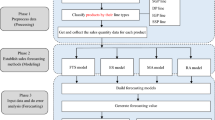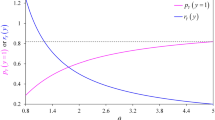Abstract
Nowadays, the success of a company is dependent to the novelty of the company in developing new items. Product design and engineering are a basic phase in developing new commodities which examines the product economically and technologically. In the proposed study, “Trust” is identified as an effective factor on the life cycle of the new designed product. This study addresses a simulation structure to generate all the possible trust modes between two agents over time and implements four prediction methods to forecast the trust value of the new item. The time horizon is considered to be short term and middle term, and 27 and 108 scenarios are designed, respectively, based on three categories involving high, medium and short trust. Here, three prediction techniques: conventional time series, artificial neural networks and adaptive neuro-fuzzy inference system, are recommended and compared. By comparing MAPEs of all prediction methods, the best technique is identified.





Similar content being viewed by others
Explore related subjects
Discover the latest articles, news and stories from top researchers in related subjects.Notes
City-block metric: If a and b are vectors with m-dimension, the city-block metric has been defined to calculate distance between a and b according to the following formula:
$$ \mathop \sum \limits_{{{\text{i}} = 1}}^{\text{m}} \left| {b_{i} - a_{i} } \right| .$$(8)
References
Azadeh, A., Saberi, M., Asadzadeh, S.M., Khakestani, M.: A hybrid fuzzy mathematical programming-design of experiment framework for improvement of energy consumption estimation with small data sets and uncertainty: the cases of USA, Canada, Singapore, Pakistan and Iran. Energy 36(12), 6981–6992 (2011)
Azadeh, A., Zia, N.P., Saberi, M., Hussain, F.K., Yoon, J.H., Hussain, O.K., Sadri, S.: A trust-based performance measurement modeling using t-norm and t-conorm operators. Appl. Soft Comput. 30, 491–500 (2015)
Brown, M., Harris, C.J.: Neurofuzzy adaptive modelling and control. Prentice Hall, Upper Saddle River (1994)
Chang, E., Dillon, T., Hussain, F.K.: Trust and reputation for service oriented environments, vol. 1(18). Wiley, Hoboken (2006)
Dowlatshahi, S.: The role of product safety and liability in concurrent engineering. Comput. Ind. Eng. 41(2), 187–209 (2001)
Demoly, F., Dutartre, O., Yan, X.T., Eynard, B., Kiritsis, D., Gomes, S.: Product relationships management enabler for concurrent engineering and product lifecycle management. Comput. Ind. 64(7), 833–848 (2013)
Fang, H., Guo, G., Zhang, J.: Multi-faceted trust and distrust prediction for recommender systems. Decis. Support Syst. 71, 37–47 (2015)
Fine, C.: Clockspeed. Perseus Books, New York (1998)
Fine, C.H., Golany, B., Naseraldin, H.: Modeling trade-offs in three dimensional concurrent engineering: a goal programming approach. J. Oper. Manag. 23, 389–403 (2005)
Jang, J.S.R., Sun, C.T., Mizutani, E.: Neuro-fuzzy and soft computing: a computational approach to learning and machine intelligence. Prentice-Hall, Upper Saddle River (1997)
Karningsih, P.D., Anggrahini, D., Syafi’I, M.I.: Concurrent engineering implementation assessment: a case study in an indonesian manufacturing company. Procedia Manufacturing 4, 200–207 (2015)
Luo, J., Liu, X., Fan, M.: A trust model based on fuzzy recommendation for mobile ad-hoc networks. Comput. Netw. 53(14), 2396–2407 (2009)
Maier, J.F., Wynn, D.C., Biedermann, W., Lindemann, U., Clarkson, P.J.: Simulating progressive iteration, rework and change propagation to prioritise design tasks. Res. Eng. Des. 25(4), 283–307 (2014)
Mashinchi, M.H., Li, L., Orgun, M.A., Wang, Y.: The prediction of trust rating based on the quality of services using fuzzy linear regression. In: Fuzzy Systems (FUZZ), 2011 IEEE International Conference, pp. 1953–1959 (2011)
Nuñez-Gonzalez, J.D., Graña, M., Apolloni, B.: Reputation features for trust prediction in social networks. Neurocomputing 166, 1–7 (2015)
Raza, M., Hussain, O.K., Hussain, F.K., Chang, E.: Maturity, distance and density (MD 2) metrics for optimizing trust prediction for business intelligence. J. Global Optim. 51(2), 285–300 (2011)
Rumelhart, D.E., McClelland, J.L., PDP Research Group: Parallel Distributed Processing, vol. 1, pp. 354–362. IEEE, Piscataway (1986)
Shidpour, H., Shahrokhi, M., Bernard, A.: A multi-objective programming approach, integrated into the TOPSIS method, in order to optimize product design; in three-dimensional concurrent engineering. Comput. Ind. Eng. 64(4), 875–885 (2013)
Tchidi, F.M., He, Z.: Systematic study of three-dimensional concurrent engineering based on an extended quality functional deployment. In: Proceedings of the International Conference on Mechanical, Industrial, and Manufacturing Technologies (MIMT), pp. 22–24. Sanya, China (2010)
Xia, H., Jia, Z., Li, X., Ju, L., Sha, E.H.M.: Trust prediction and trust-based source routing in mobile ad hoc networks. Ad Hoc Netw. 11(7), 2096–2114 (2012)
Xu, L., Li, Z., Li, S., Tang, F.: A decision support system for product design in concurrent engineering. Decis. Support Sys. 42, 2029–2042 (2007)
Yaghini, M., Khoshraftar, M.M., Fallahi, M.: A hybrid algorithm for artificial neural network training. Eng. Appl. Artif. Intell. 26(1), 293–301 (2013)
Zhu, A.Y., von Zedtwitz, M., Assimakopoulos, D., Fernandes, K.: The impact of organizational culture on concurrent engineering, design-for-safety, and product safety performance. Int. J. Prod. Econ. 176, 69–81 (2016)
Author information
Authors and Affiliations
Corresponding author
Rights and permissions
About this article
Cite this article
Azadeh, A., Sadri, S., Saberi, M. et al. An Integrated Fuzzy Trust Prediction Approach in Product Design and Engineering. Int. J. Fuzzy Syst. 19, 1190–1199 (2017). https://doi.org/10.1007/s40815-017-0314-1
Received:
Revised:
Accepted:
Published:
Issue Date:
DOI: https://doi.org/10.1007/s40815-017-0314-1




